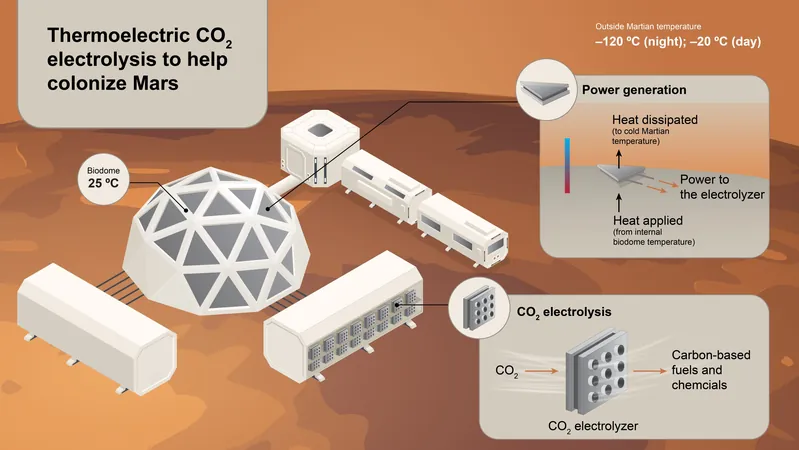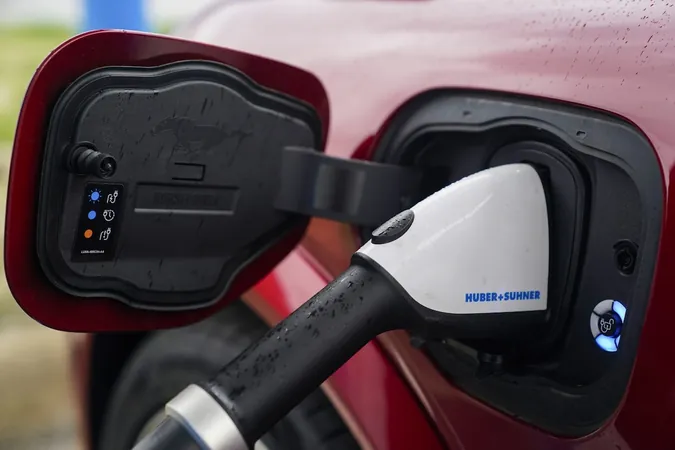
Revolutionary Thermoelectric Generators Could Transform CO2 into Fuels for Mars Colonization!
2024-11-07
Author: Charlotte
Introduction
A groundbreaking study from chemists at the University of British Columbia (UBC) suggests that readily available thermoelectric generators, operating under even modest temperature differences, could pave the way for powering the conversion of CO2 into valuable chemicals—an innovation that could be pivotal for future Mars colonization.
The Potential of Thermoelectric Generators on Mars
This exciting research reveals that the temperature variations found in diverse environments, from geothermal sites on Earth to the harsh, frigid surface of Mars, may harness the power to transform carbon dioxide into useful fuels and chemicals. “The environment on Mars really inspired my interest in the long-term potential of combining these technologies,” explains Dr. Abhishek Soni, a postdoctoral research fellow at UBC and the lead author of the study published in the journal Device.
Challenges and Opportunities on Mars
Mars presents a unique challenge; the planet’s atmosphere is composed of approximately 95% carbon dioxide, coupled with extreme temperature fluctuations ranging from a balmy 20°C to a chilling -153°C. The ability to convert this abundant CO2 into practical resources could be a game-changer for sustaining human life on the planet.
Dr. Soni elaborates, “This harsh environment allows us to exploit large temperature differences—not only to generate power using thermoelectric generators but also to convert CO2 into essential products that could support a Martian colony.”
How Thermoelectric Generators Work
Thermoelectric generators create electricity by being placed in environments with significant temperature differences. The research team discovered that when the temperature gap between these generators was at least 40°C, they could generate sufficient steady current to power an electrolyzer that facilitates the conversion of CO2 into carbon monoxide.
Applications on Earth and Mars
Closer to home, this technology can be integrated with geothermal installations, capitalizing on the temperature difference between hot pipes underground and the cooler surface temperatures. “Our findings show that these generators can effectively power converters using the thermal differences found in geothermal systems,” Dr. Soni said.
On Mars, the vision includes biodomes that maintain comfortable, room-like temperatures for human habitation. By positioning thermoelectric generators along the biodome’s surface, the stark contrast between the interior and the frigid Martian exterior could produce the energy necessary for CO2 transformation.
Future Implications
According to Professor Curtis P. Berlinguette, a principal investigator at UBC, this development is not only innovative but also essential: “This research presents an exciting strategy for producing carbon-neutral fuels and chemicals. One day, we'll need plastics on Mars, and this technology shows a feasible path to create those materials right on the planet.”
As humanity prepares for potential colonization of Mars, the next crucial phase of this research will be testing the functionality of thermoelectric generators alongside electrolyzers under real-world conditions on Earth. The implications stretch beyond space exploration; this technology could also help address carbon emissions and promote sustainable energy solutions on our own planet.
Conclusion
Stay tuned as we continue to explore how this revolutionary technology could save our future—not only on Mars but right here on Earth too!









 Brasil (PT)
Brasil (PT)
 Canada (EN)
Canada (EN)
 Chile (ES)
Chile (ES)
 España (ES)
España (ES)
 France (FR)
France (FR)
 Hong Kong (EN)
Hong Kong (EN)
 Italia (IT)
Italia (IT)
 日本 (JA)
日本 (JA)
 Magyarország (HU)
Magyarország (HU)
 Norge (NO)
Norge (NO)
 Polska (PL)
Polska (PL)
 Schweiz (DE)
Schweiz (DE)
 Singapore (EN)
Singapore (EN)
 Sverige (SV)
Sverige (SV)
 Suomi (FI)
Suomi (FI)
 Türkiye (TR)
Türkiye (TR)